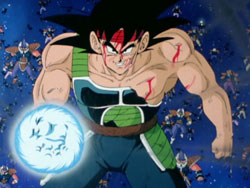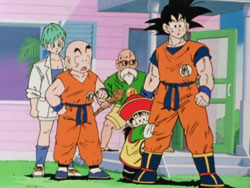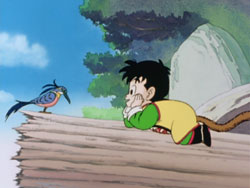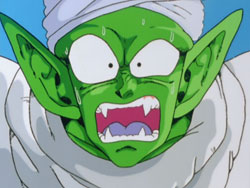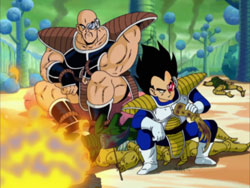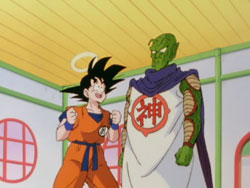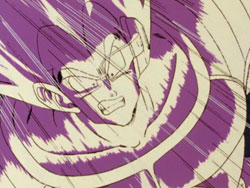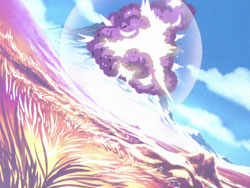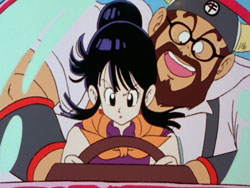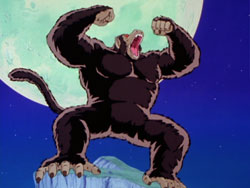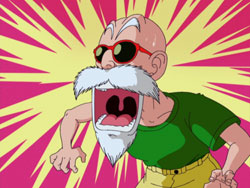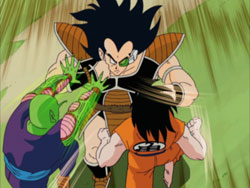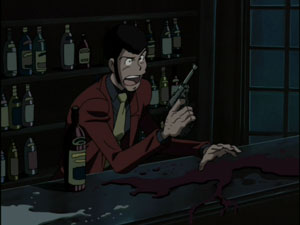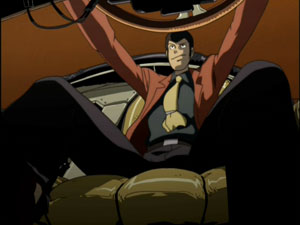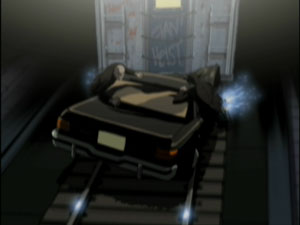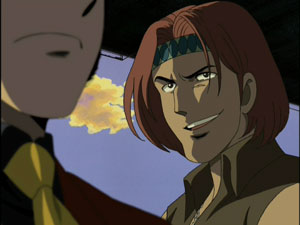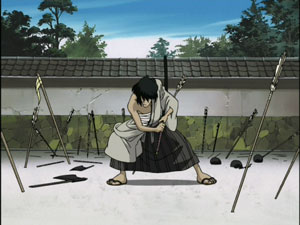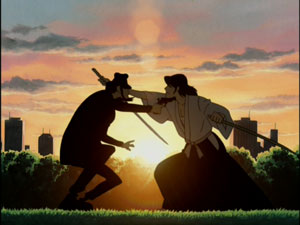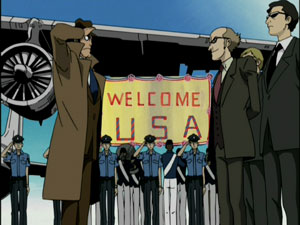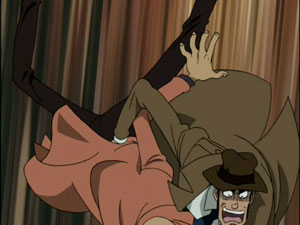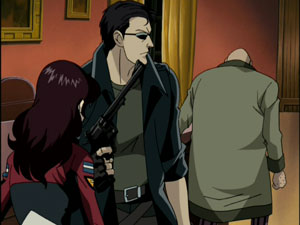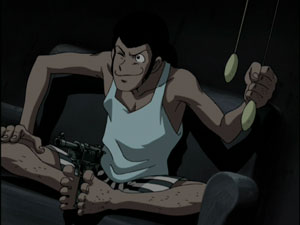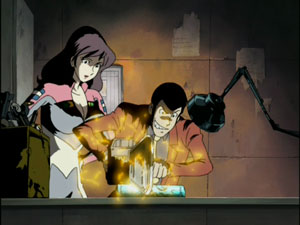 Logo handmade by Bannister
Column by Scott Green
Logo handmade by Bannister
Column by Scott Green
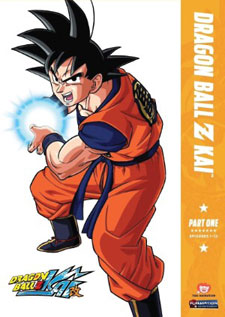
Dragon Ball Z Kai Season 1 Part 1 Released by on DVD and Blu-ray by FUNimation Airing on Nicktoons, starting May 24 at 8:00pm official site
Once upon a time, there was a monkey tailed boy named Son Goku who was punching out giant dinosaurs in the jungle, when his path crossed with an undergarments named, blue haired girl (Bulma, as in "bloomers") driving her motorcycle. The entirely naive boy, and the girl inventor, and a desert bandit and a shape changing pig teamed for a pilgrimage to find seven balls that, when brought together, summon a wish granting dragon (this is a parody of the classic Chinese novel Journey to the West with the monkey boy sitting in for the Monkey King and the girl in the role of monk Xuanzang). They fight off an impish would be-conqueror accompanied by a woman in an overcoat and a dog ninja, a paramilitary group, a cadre of classic monsters and the like. The monkey boy would find a stubby monk to serve as his martial arts rival and the two would be tutored by a turtle shell wearing hermit and compete in various martial arts tournaments against strange adversaries, leading up to a series of confrontations with the devil - a green skinned guy with antennae. That constituted the Dragon Ball anime series. Though the original manga never updated its title, the next phase would be labeled Dragon Ball Z for its anime adaptation. The monkey boy, now a man, though not necessarily more mature, is a parent of his own monkey child. Turns out, he was never really just some aberrant wild child. He was a Saiyan, a race of alien conquerors. In a sort of evil twist on the Superman scenario, he was sent as an infant by the people of his soon to be doomed planet to devastate Earth. Except, he got hit on his head as a baby and lost his evil impulses, becoming the beloved hero instead. Unfortunately, more of his race are on their way to Earth, and our hero must up his game to face warriors out of the league of even the gravest previous threat. Then, that origin gets rewritten again. Turns out, the Saiyan home planet was destroyed by an even more power evil overlord, and our hero must content with the new uber-threat.Begun in 2009, the aims of Dragon Ball Z Kai are to condense the 1989, 291 episode Dragon Ball Z anime into 100 episodes, remaster/tweek the video to look more like it was just produced, clean up the voice work with the original cast, and in general get Dragon Ball Z into the shape of being a current, rapidly paced shonen adventure anime, faithful to the original Akira Toriyama manga. On a scale of Kamehahaha to Genkidama, I'd give this effort a... actually, I don't know Dragon Ball quite that well. It'd call it a resounding success. Despite its age, I don't think I can recall anyone knocking Dragon Ball Z as "looking old." With the new coat of finish, Kai eliminates any chance of that trouble cropping up for a while longer. The production apparently aims to give what fans remember best of the series and at the same time make it more appealing to new comers. I don't expect even Dragon Ball's most ardent devotees to miss the trimmed fat. With the editing, there are bits that come out of nowhere or go nowhere. But, veterans know what filled those gaps. For newcomcers... as a child of the 80's, I can attest to the fact that the target age/demographic for Dragon Ball Z Kai have loved far more spastic, incoherent television. Compared to late seasons of Thundercats, Kai is Hemmingway. Especially if an anime isn't apt to be mentally taxing, I'm liable to watch some of it while doing cardio exercise. I'm training for a jiu jitsu tournament, so, with my upped cardio effort, over the course of the last week, I made it through all of Dragon Ball Z Kai, a good chunk of Fullmetal Alchemist: Brotherhood and a bit of Mightiest Disciple Kenichi while jump roping. Testing Kai on the action-anime appropriate gauge of whether it inspired me to exercise more vigorously, I'd give it a passing grade. Even in its new fighting weight, Dragon Ball is still structured as long form tournament anime. Meaning that excitement waxes and wanes with a cycle of denial and reward. The 13 episode set takes Dragon Ball Z Kai into a major battle between Goku and rival Vegita, but not before a slimmed set of training episodes. Monkey King Goku might be a static character, an excitement loving white hat to the end, but other members of the cast do evolve. Even if the inclined could pick it apart, a key element of Dragon Ball Z's winning formula has been that sense of growth and development. Still, Gohan and Picollo learning to become heroes aside, Dragon Ball is fight anime through and through. There are episode of Dragon Ball Z Kai that manage to trigger the flow of adrenaline for me. They're in the minority, but they're there. Late in the set, heroes and villains begin a high stakes exchange of brutality. As these super-powered martial artists began cooking off each other's limbs, knocking each other into the ground and re-sculpting the map in battles of space kung-fu versus spirit world karate, DBZ did manage to help my cardio work. Personally, I've only ever been able to muster mild interest for Dragon Ball. Most of its pre-Cartoon Network TV airings never fit into my schedule. Despite excruciating reception, I did put on bits of the raw Japanese run on the International Channel to have something colorful going on the TV. It was by no means appointment viewing, but I did turn to the late night, weekday airings during the Cartoon Network run for a stretch around 2000. And, I've spot watched the various DVD releases. The typical knock on Dragon Ball Z has been its pacing. After the "over 9,000!" power ranking exclamation, the second most meme replicated Dragon Ball phrase might be "still on Namek," a reference to the sixty odd episodes the series spent getting to and fighting on an alien planet. A number of these were supposed to depict a five minute stretch of time. I certainly concur that pacing is an issue for Dragon Ball Z. Actually, that's probably a bit of an understatement. But, never having sit down to watch long stretches of the series, the famously painful slowness wasn't my problem. I just never connected with the characters. That would be fine in a work as action focused as this, but I didn't care for the action either. Dragon Ball director Daisuke Nishio was attached to my favorite action anime, and one of my favorite anime of any type, Air Master. Adapted from a seinen manga by Yokusaru Shibata, the anime told the story of a six foot tall former competitive gymnast (voiced by Romi Park, Fullmetal Alchemist's Ed) who went into a depression following the death of her mother, who is revitalized when she discovers the competition offered by street fighting. It's certainly extravagant with its action. As the title might apply, Maki's signature moves typical involve her jumping 10's of feet into the air to spin kick or stomp on opponents' heads. Besides its crew of amusing characters, what I love about Air Master is its complex, dynamic fight choreography. Each fighter has their own style, and that employed repertoire shifts along with their emotions and the extent to which they figure out how to best their opponents. In contrast, I've always seen Dragon Ball as a bit of a scrum. A lot of pushing, a lot of competitive heft, and a lot of difficultly seeing what's going on. Combatants exchange flash punches and kicks at blinding speed. They heave glowing balls that in most cases are either met with complementary glowing balls, or which miss their intended targets, blowing up mountains or scarring landscapes in the process. The spectacle is that of a contest of power. An anime strong man to Air Master's MMA. I can put up with dreck in anime if I like the character of its fighting. Neither condition is met here. Dragon Ball isn't dreck. Never meant to be profound, it's the anime equivalent of a silver age super hero comic. The flash of light, sound of thunder fight style isn't generally what I prefer in anime tussles, but complemented by the fully committed expressiveness, I can appreciate that it effectively applies a vision of planet shattering martial arts clashes to the medium. Everything, especially the extravagantly driven characters,, whether genial heroes, clench jawed rivals or maniac villains, is played to the hilt. And, in a fun embellishment, it occasionally draws in Toriyama's notion of logic free possibility. Dragon Ball Z was less about invention and more about the thought that if you're going to blow something up, make it planet sized. And yet, it was set in a wacky world that, without any justification, afforded Toriyama the freedom to do whatever sparked his synapses. As such, it's not just that characters occasionally smack around dinosaurs, if there's a crowd shot, walking dogs and bulls and such will inevitably be mixed in with the humans. People... well, typically male, typical young, really like Dragon Ball, and I've never felt the need to argue against its appeal. It is after all, one of the most important anime/manga series. It hit at the right time for it to lodge itself into North American consciousness. Anime World Order has a line about how everyone is allowed a shonen fight series that they can love irrationally. For a lot of Americans, that was Dragon Ball. And, FUNimation has repeatedly, publically made the point, it still is. Internationally, there are other series like this. Bruce Lee meets Road Warrior - Fist of the North Star and mythology meets pro-wrestling - Saint Seiya to name a few. Neither hit America in the right mode at the right time to garner a significant following, but they have plenty of fans across the globe and regularly receive revivals in Japan. What sets Dragon Ball apart is that it, or at least its creator, Akira Toriyama, is credited as a key inspiration for a generation of shonen manga creators, including One Piece's Eiichiro Oda, Naruto's Masashi Kishimoto, Fairy Tails's Hiro Mashima, and Soul Eater's Atsushi Okubo. In a number of cases, the creators have chalked up similarities in their work to like Toriyama influences. If Osamu Tezuka was the God of Manga, and Go Nagai was the dirty uncle, Akira Toriyama was the school record breaker... the guy whose name is on the wall, who the new comers all aspire to be. Dragon Ball Z calcified in the transition from the original Dragon Ball as it focused on preparing and fighting the next iteration of powerful uber-threat rather than have its heroic monkey boy try his kung fu out in one strange situation or another, but its application of a sense of possibility to the tableau of an energetic hero as his grin turns to righteous anger still resonates among both fans and creators. Dragon Ball K is primed to enthrall a new generation of adolescents while pleasing the previously hooked. While it didn't convert me into a Dragon Ball Z fan, it did keep my attention. I can certainly see why, in its domain, Dragon Ball is an undeniably classic. There's always going to be an audience for animated work full of screaming and exchanges of explosive attacks. Kai reestablishes that Dragon Ball Z is the premiere anime for that audience.
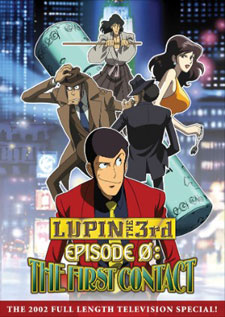
Anime Spotlight: Lupin The 3rd Episode 0: The First Contact Released by Discotek/Eastern Star
Syndicated Astro Boy hit North America in 1963, and as would be expected from TV at the time, episodes stood on their own. Jump forward 25 years. Star Blazers and Robotech attracted a following in part due to epic scope established by ongoing narratives and developing storylines. Akira and Streamline releases like Wicked City, Vampire Hunter D and Golgo 13 come along - or later movies like Ninja Scroll and Ghost in the Shell. And... how many viewers could really explain the end of Akira? It was the spectacle and not the narrative that pulled the audience. Sailor Moon, Dragon Ball Z and Gundam Wing aired on TV, and the continuity and character development helped to distinguish anime from cartoons and prime time programming of the period. This attachment to emphasized narrative got cooked into the anime boom, and, despite some well liked counter examples, as Nelson Reed notes in the commentary track for this DVD, anime fans have gravitated towards running stories and away from episodic works. This probably isn't the only reason why Lupin III only has a small, intense following in North America, but it seems a likely contributing factor. Now, the pendulum might be swinging back. As anime enthusiasm in North America has cooled, more voices have begun to suggest reaching out to the non-dedicated watchers... the people who used to like the spectacular movies. Few watchers of Afro Samurai were there for its plot evolutions. When I've recommended RIN ~Daughters of Mnemosyne~ and Shigurui: Death Frenzy to lapsed anime watchers, it hasn't been because of their engrossing narrative. Same applies to the growing number of commentators boosting Madhouse's racing anime Redline.The 2002 90 minute TV special Episode:0 offers what it takes to please anyone with a taste for lightly plotted anime spectacle, regardless of familiarity with the title character. It takes seconds to get that not so gentlemanly gentleman thief. Decked out in half-(dated)-fashionable jacket and tie, he's a hairy, lanky figure with his hands in his pockets, perpetually ready to draw a trick gadget or pistol. With a grin in the face, of danger he grabs what he wants and runs away. Hyper-competent, indomitable and free, anime couldn't ask for more a perfect hero for episodic extravaganza. While most Lupin III adventures purport to capture the thief at some point mid-career, The First Contact stands out in the franchise as the declared first meeting of Lupin III and his cadre - scruffy, sour gunman Daisuke Jigen, laconic, precise samurai Goemon Ishikawa XIII, object of lust and frequent double crosser Fujiko Mine and perpetually pursuing, perpetually foiled, Inspector Zenigata. In reality, Episode 0 is not so much about tracing careers and establishing backgrounds as it is a caper with more antagonism between members of the Lupin group. It's not new for some subset of Jigen, Goemon and Fujiko to work against Lupin and the rest, or for that matter, in movies and specials, for Zenigata to make a temporary truce with Lupin. This is a Battle Royale. Lupin against the world... the rest of the ensemble and a group of mobsters for good measure. Lupin, Jigen and Fujico are apparent antecedents to Cowboy Bebop's Spike, Jet and Faye. That popular anime had a number of fun scenes in which its tragic free spirit, tired ex-cop and gambler were collaborating, but clearly thinking and operating on their own divergent, unswaying paths. Part of the enjoyment of Episode 0 is seeing the antithetic styles of the Lupin crew actively opposing each other. The contrast from other Lupin anime is novel, especially the dynamic of Jigen doggedly trying to put a bullet between Lupin's eyes as the thief springs away. But, the configuration also accentuates what a strange intersection of characters from their own domains the series is. Lupin, jigen, Fujico, Goemon and Zenigata... each of these could be the star of their own adventures and separated out, the tone of those solo exploits would be decidedly distinct from their joint activities. Each of the personalities is acted out on its own register. A pleasure of Episode 0 is seeing the puckish Lupin frustrate the other character types. Episode Zero is written by Shoji Yonemura, the pen behind the well regarded, violently action focused Lupin III: Island of Assassins (he and director Minoru Ohara previously worked together on Gonzo/Satelight's Euro-history inspired space opera - an ambitious, often underachieving mess). There's concerted gunplay here and an uncomfortably assaulty bit with Fujico, but in contrast to the savage for the throat snap of Island of Assassins, Episode Zero is a gleeful romp. New York and film presentations of America are this special's playground. Among its serial set pieces, it offers up a reworked version of French Connection's car chase, homage’s to the Warriors and Terminator and characters with names from Back to the Future woven into references from earlier Lupin III anime. It's a diverting juggling act. References are turned with agile pizzazz as clock towers and time locked safes swap places with Manhunter name checks and elevated trains. The same dexterity applies to integrating Lupin's extravagant tricks into the gunplay heavy action. Speed trumps pride here. Maybe because no point was seen in dwelling on the familiar or maybe it's supposed to be a function of Lupin squaring off against his similarly skilled companions to be, but rather than flaunting gadgets and fake outs, Lupin will employ and dispose of his tricks with the same crack speed used by Jigen to draw his pistol or Goemon his sword. Episode 0 hits the throttle early with Jigen interrupting a Lupin caper with gunfire. From there the blitz of a reference heavy car chase establishes the special's velocity. The movie is exciting enough, long enough to be worth watching. The problem in the later goings isn't that Episode 0 dulls. It's that this special can't and doesn't culminate into much. It has to end with Lupin and company joining forces. At the same time, the special doesn't offer a one-off adversary who can challenge the heroes. Pieces are in place for some climactic send-offs to elements of the story, but those are swept away in the motion of the unified group. The end of Episode Zero was a foregone conclusion, and it does try to extricate itself from that trap, but its success hardly mirrors that of its wily protagonist. The difficulty inherent to any prequel is compounded by the difficulty of working with the Lupin series. Though clever in executing its set pieces, the special doesn't have the head to contend with this challenge. Following Hayao Miyazaki's delightful Euro-trip Lupin III: Castle of Cagliostro, the revered director's friendly antagonist Mamoru Oshii was supposed to direct a movie featuring Lupin III. Oshii planned to do what he later did with the Patlabor movie, present a story that captured the effect of Lupin, without Lupin himself present. Lupin has always been as much the concept of a maelstrom of late 60's free, rebellious energy as he was a character. The whole proceedings were supposed to be mercurial. For example, there was the idea to have a series of women named Fujico playing against Lupin rather than a single, specific character. When Monkey Punch launched his Mad Magazine inspired Lupin III in 1967, the toplessness and attitudes could have found a home in Playboy. The character's lust and greed were bent into devilish comic devices as his Neolithic manners propelled him in and out of stabby, shooty mouse traps set pieces. It was a work of manga that loved comedic process. It churned with maniacal trickiness, both in static scenarios, with Lupin locked into a space with a deadly opposition or dynamic ones, with the character shooting through some physical space. And, it was a work that loved irreverent crudeness. A favorite chapter illustration shows a rifle carrying Fujico looking in bewilderment as Lupin, Jigen and Goemon's hands project weapons out the ground, Lupin's having caught her undergarments on his outstretch firearm. The animalistic mentality of the would be-rapist, would-be killer Lupin didn't really survive into his anime incarnation. There was a 1972, 23 episode anime TV series, marked by the character's green jacket. Though it initially targeted an adult audience, it shifted to make the character more presentable for a broader viewership. He was an uncouth cad, but he no longer had the dark side where he'd assault women and kill men. This "green jacket" version featured the works of Masaaki Osumi, Hayao Miyazaki and Isao Takahata. Then, there was the more successful, younger audience aimed 155 episode "red jacket" version that started in 1977. Two episodes were directed by Hayao Miyazaki . The final TV series was a third, "pink jacket" series that began in 1984. After the live action theatrical feature Lupin III: Strange Psychokinetic Strategy, starting in 1978, five animated Lupin III movies were produced: three red jackets, one green, one pink. Among these were Hayao Miyazaki's classic adventure Castle of Cagliostro (the green jacket one), Lupin III: Legend of the Gold of Babylon from Seijun Suzuki (Branded to Kill), Lupin III: Farewell to Nostradamus from Shunya Ito (Female Prisoner Scorpion) and Dead or Alive, directed by Monkey Punch himself. Then, starting in 1989, there were annual Lupin III made-for-TV features. Five out of the first seven of these were directed by Osamu Dezaki, the influential director or Rose of Versailles, Tomorrow’s Joe, Space Adventure Cobra, Aim for the Ace, some of the first Astro Boy, and noteworthy to American's Bionic Six. Later specials were directed by a range of talents, including Shinichi Watanabe aka Nabeshin. So, you have a character that can be bent to visions from Kurtzman inspired Monkey Punch to Hayo Miyazaki to Seijun Suzuki. The incorrigible free spirit can be cold and lethal or noble hearted, and as long as he's the fox in the hen house, it's true to the core principle of the series. With this character denying definitive definition, there's been some giving way to urge to deconstruct him and go meta. By most reports Lupin III: Red vs Green, featuring a meeting of the different incarnations of the character, wasn't especially good. If you care about Lupin III, you can probably guess that he's going to elude being pinned down by a story. That doesn't necessarily preclude the construction of a satisfying narrative. Episode 0 offers all the eye candy that could be asked for from a Lupin III adventure. This is a bender through New York that should bring a grin to the face of any cine-phile. The idea of an origin story allows Lupin to face off against all of his allies, and that dynamic benefits about two thirds of the special. The last third has to either solve or circumvent to challenge of committing Lupin to something, and, when the time comes, it allows the resolution to look like a foregone conclusion. It's a marvelous bit of arcrobatics that fails to stick the landing. As an anime specicle, it rides high earlier, and deflates late.

Manga Spotlight: Kingyo Used Books Volume 1 by Seimu Yoshizaki Graphic novel released by VIZ Signature Serialized online on Sigikki
Speaking of Lupin III, the manga was a peculiar release, put out at an exciting time in manga, when the industry was really beginning to establish its expansive boundaries. When I recently Twittered about the manga, it sparked plenty of reminiscences from those who bought it back in 2002/2003. I remember when a neighbor lent me a copy of X:Men - From the Ashes, my introduction to comics. I remember taking a chance on a purchase of Osamu Tezuka's Adolf in Cambridge's Million Year Picnic, having the book wow and encourage me to start delving into what manga had to offer. I remember someone's jaw dropping as they were introduced to Blade of the Immortal. That's what Kingyo Used Books is about. It's a love letter to manga that readers who love media will love. I was nearly won over by Kingyo Used Book's love for obscure, interesting manga, and even more when it directed some attention to Jean Giraud's western Blueberry. Still the transparent display of affection was something to which I was at odds. As much as I'm interested in history and dissecting the appeal of media, to quote Tony Soprano, "'remember when' is the lowest form of conversation." That might be overstating the case, but unsentimentality, combined with misgivings about the subject prompted an "it's not you, it's me" reaction to Kingyo Used Books. I can see people loving this manga. I can see AICN readers, and especially contributors loving the manga. Yet, I have to say, it went for a reaction to which I'm resistant. Stories that validate an interest put me on guard. This might not be entirely rational on my part. Essays don't sound the warning claxons to the same extent, but s soon as you give it an invented narrative, the trepidation creeps in. So many people are prone enough to fit beliefs to what they'd like to be true when they're working with theories and anecdotes. When invention comes into play, my limit tends to get passed. If I don't share the subject interest, I'm rolling my eyes (most "love of the game" or nostalgia based sports movies for example). When it's an interest I do share, I find myself too conscious of the complement. For example, Genshiken: The Society for the Study of Modern Visual Culture - about a college anime/manga club is a series that I enjoy, but, in the back of my mind I'm casting dark clouds over its warm glow of self-justification. "Kingyo" means goldfish and a simple six lined scrawled drawing serves as the titular shop's emblem. It's the principle of manga and comic at work, the abstract and stylized visual representation of an idea. Here, Kingyo Used Books, provides a stylized version of how manga insects with life's developments. Kingyo's first story, The Components of Memory finds an adult stumbling onto the used book shop. He wanders in, and begins asking the young woman behind the counter about whether the shop would buy off some of his manga. The woman looks a bit hurt, but she's really provoked when he says "I'm not a kid anymore. It's kind of pathetic to keep reading manga forever. I'm thinking it's about time to start reading something else." She throws her hands over his mouth. As he returns home and begins sorting through what to sell off, he stumbles onto a letter reminding him that there's a 20th elementary school anniversary coming up. The old friends find it weird to see people they knew as kids drinking alcohol. There mood darkens when the group discusses a friend who got laid off, but then, there's talk of an absent classmate who pursued volunteer work in Africa. Reportedly what he misses most about Japan is its manga. Another confirms that his business trips to Hong Kong are more bearable thanks to its manga shops. A classmate introduces the subject of this story to her young daughter then returns a long borrowed copy of Akira Toriyama's pre-Dragon Ball comedy Dr Slump (there's a great appendix from real used book seller Hiroshi Hashimoto, with discussions of the works mentioned in Kingyo, their appeal and their influence). The group passes around Dr Slump, calling what it took to obtain the manga and the joy they got from it, and they really begin remembering what they felt when they were young, spending time with each other. There's a manga/anime that was popular about five years or so ago called Azumanga Daioh, about a circle of girl friends thorough out high school. The Seinfeld "comedy about nothing" phrase was frequently forwarded to describe it, but really, the manga was about the in-between moments in a high school career. Azumanga moved towards the graduation of the subjects, but focused on the pleasures between classes. In Azumanga Daioh, and in Kingyo Used Books (as noted here), there's an essential "mono no aware" emotional note, a sense of how things move on. It's nostalgia, but nostalgia for things that may not be gone yet, or may not be how they'll be remembered. Manga, for the most part is an ephemeral object. You have it. You read it. The time is gone, and in many cases so is the manga. This initial story, "The Components of Memory" marks how manga serves as cobble stones paving life's good times, not so much a marriage, graduation or major accomplishment, but the minor pleasures. That first story also contains a scene in which its subject is in a crammed subway car, lamenting the burdens of his life, when he sees a man reading a volume of manga, unbothered by the conditions of the commutate. In a sense this is pinning manga to its traditional place, one which is being eroded from underneath. Manga publishers generally haven't been doing well in recent years. There are plenty of critiques of how the industry is organized and how talents and franchises are fostered, but a frequently identified concern relates to where once people turned to manga to pass time, mobile electronics are now filling the niche. While the scene calls the issue to mine, it's not an explicit element of Kingyo. It's that man's relationship to manga that's instrumental to Kingyo. The series aims to explore the (positive) role manga has in the lives of its stories' subjects. It offers a young woman wrestling with her inability to live up to her artistic inspiration (ukiyo artist Katsushika Hokusai - or specifically Sarusuberi, a manga about the artist and his daughter), a half Japanese, half American young man who found identity through the stories of boy detective Billy Puck, or the moral code of a woman who looks for used books she can resell for higher prices. Personalities are exaggerated and probability is stretched as Kingyo Used Books works to build parables about the value of manga to these subjects. Manga becomes a tool with which a person can decompress and reflect, an instrument for reconciling relationships, developments and less than rational needs. For all the earnestness and occasional emotional peaks, his is a light, pillowy exploration. Kingyo Used Books is from Ikki, an anthology on the alternative side of things. (For background, read Ed Chavez's Otaku USA piece). And, it's from a creator with a bevy of quirky works to her name. If you think alternative is synonymous with abrasive, Kingyo's view of the importance of things that aren't driving will disabuse you of that notion. Because Kingyo Used Books is eminently likable it is not entirely persuasive. You don't need to be a manga fan for Kingyo to bring a smile to your face, but you do have to be amenable, possessing in interest in some like medium and receptive to the tone and nature of its message. It wouldn't be what it is if it was presenting a more forceful argument. I can see Kingyo Used Books emotionally effecting readers. Consummate media lover that I am, I appreciate the sentiment and credit Kingyo with effectively conveying it. I'm old enough, and loved manga long enough to have manga tied to memories of earlier stages in life. As such, I get Kingyo Used Book. If I was more sentimental or more open to flattery, I probably really like it.

